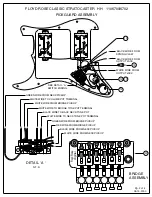
Re-Stringing
The procedure for re-stringing acoustic guitars,
electric guitars and basses, is quite similar in the way
the strings are wound onto the tuning machines.
There are differences though, in how the strings are
attached to the bridges of acoustic and electric
guitars.
Guild flat-top acoustics have a pin style bridge with
holes and bridge pins to hold the strings in place.
Guild jazz and electric guitars have a surface
mounted bridge or slotted tailpiece through which the
strings are fed.
To string a flat-top, remove the bridge pin and the
old string, drop the ball end of the new string into the
hole in the bridge, then re-insert the bridge pin to
keep the string in place. Make sure that the bridge pin
is positioned with the groove over the string. Do not
hammer the bridge pin in. A firm push with the
thumb will secure it in place.
To string an electric, simply feed the string through
the appropriate hole in the bridge or slot in the
tailpiece.
To attach a string to the machine head, thread it
through the hole or slot on the machine head, running
it halfway around the post, then underneath the main
length of the string. Next, pull the string end back
over the main length.
See illustrations 1, 2 and 3.
Make sure that each string is seated well, stretched
and snugged down on the tuning machine post. This
will prevent slipping and save you some tuning
frustrations down the road.
Note: Never cut a string to length before putting
it on your guitar and tuning it to pitch. Premature
cutting may cause the string to unwrap and
become useless.
Crimp the string first, then clip near
the machine head post.
12
Illustration 1.
String is passed through
hole near top of string post.
Illustration 2.
String is then wound halfway around post.
Illustration 3.
Prevent string slippage by running the short end halfway around
the post, then underneath and back over the main length of string
before tightening.
13
Summary of Contents for GUILD - REV B
Page 13: ......

















